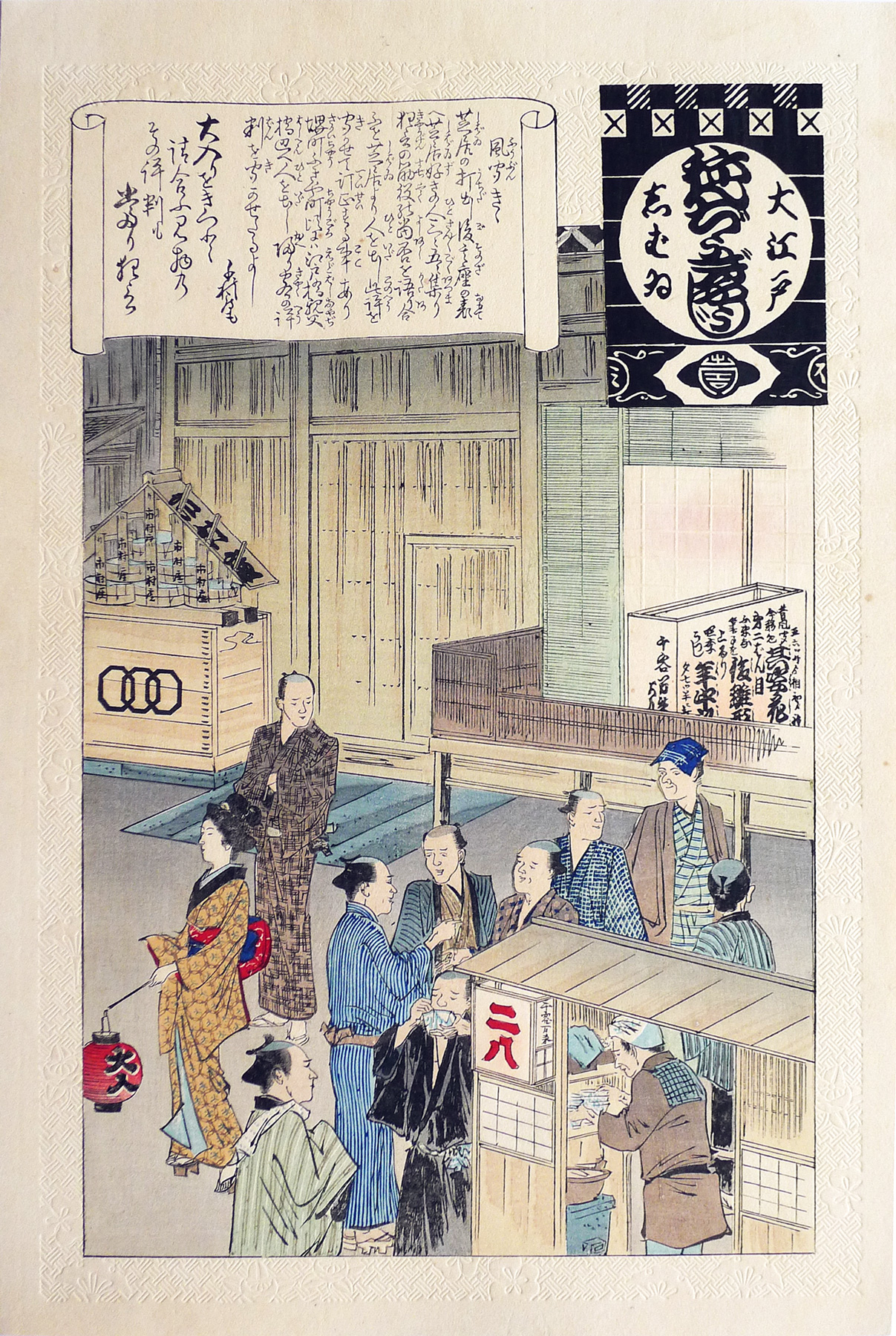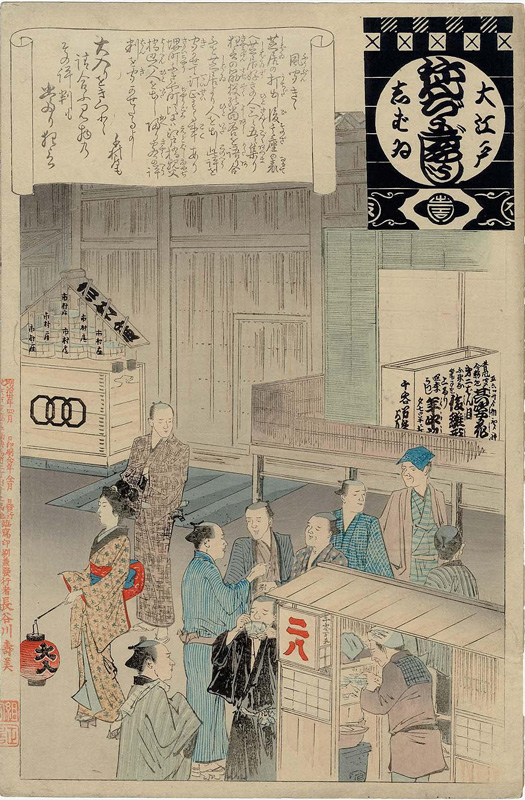About This Print
This print, part of a series of twenty-five prints (plus a prolog/index print) picturing events in a typical year in an Edo theater, depicts a soba (buckwheat noodle) stand in front of the Ichimuraza Theater, which is one of the three officially recognized Kabuki theaters of Edo. "Nihachi" (二八, literally 'two-eight'), seen on the noodle stand, came from the noodles that cost sixteen (two times eight) mon a bowl and also from the proportion of 20 parts udon flour to 80 parts soba flour.Source: Ritsumeikan Art Reseach Center http://www.arc.ritsumei.ac.jp/lib/vm/kabuki2015_e/2015/11/post-17.html
After a performance, spectators enjoyed criticizing the program of the day, eating soba in front of a theater. Both critical and favorable reviews were useful for the theater promoters to make the next performance better. Therefore, theaters often sent some people as spies to those places to gather spectators' comments and proactively reflect them by replacing or revising programs.Fūbun kiki
With the excitement of the experience still in the air, fellow theatre afficianados might pass time after the performance exchanging opinions about what they had seen, as depicted in this print of men standing around talking in front of the theatre while slurping noodles from a food cart. Collecting this gossip was useful to the theatres. Spies would be sent out to listen in, and according to what they heard, acts might be replaced or play content might otherwise be modified. This print depicts a time before the three licensed Edo theatres (Edo sanza) were forced to move to Saruwaka-chō in Asakusa as a result of the Tenpō Reforms (1841-1843). The Nakamura Theatre was still in Sakai-chō and the Ichimura Theatre was still in Fukiya-chō.
About This Series
Source: Tokyo Metropolitan Library http://www.library.metro.tokyo.jp/Portals/0/edo/tokyo_library/english/modal/print.html?d=20; ARC http://www.arc.ritsumei.ac.jp/lib/vm/kabuki2015_e/2015/11/oedo-shibai-nenjyu-gyoji.html and from personal observation.
Ōedo Shibai Nenjū Gyōji (Annual Events of the Edo Theater) drawn by Adachi Ginko [with two prints, Yomitate (Public Reading) and Saruwaka Kyōgen (IHL Cat. #2015), contributed by Torii Kiyosada (1844-1901)] is a set of twenty-six prints (including an index/prologue page), depicting the manners and customs relating to Kabuki plays/theaters in the Saruwaka-chō, the Kabuki theater district which flourished until 1867, the first year of the Meiji Era. The Ritsumeikan Art Research Center posits that this series was issued in response to the public's "remarkable nostalgia for [the] Edo period, the 'Great Tokugawa Epoch'." It goes on to say that this series is a continuation of the many earlier Kabuki theater guidebooks which "introduce[d] not only about things on a stage but also properties, organization of theatres and backstage."
Three Editions
At least three editions of this series were released. One edition, likely the first edition, contains the publisher's name, Hasegawa Sumi, and associated publishing and printing information along the left margin. This first edition, with the publishing information, is often found bound into volumes, with the margins of the prints trimmed back. My guess is that these bound volumes were created by the publisher. Another edition, likely a second edition, uses an embossed border around the entire image which is not present on the earlier edition. Generally these second edition prints have wider margins than the first edition. It is possible that these second edition prints were sold by subscription. A third edition, which appears to be printed from new blocks, as differences in composition in each print can be seen, is a less elaborate printing than the earlier editions. Interestingly, this later edition uses the convention called komochiki of a thick notched line and thin black line framing the subjects, a popular Edo textile pattern thought to reflect iki taste (Edo chic). Use of this type of framing is associated with kōkanfuda, a type of votive offering print. (See IHL Cat. #1686 A Set of Three Nōsatsu Kōkanfuda - Fūjin the Wind God, Raijin the Thunder God, Calligraphic Cover Sheet for more information about kōkanfuda.)
Summary of Differences Between the Three Editions1. First edition prints contain the publishing and printing information, including dates, along the left margin. In the later edition of prints only the Index/Prologue print contains any publishing information, with the publishing house 長谷川 板 (Hasegawa han), proceeded by the publisher's address embossed in the lower left corner. No date is given on this print or any other later edition prints.2. Most first edition prints contain the artist's signature and/or seal. Later editions do not carry the artist's signature or seal.3. Second edition prints contain an approximately 1/2" wide embossed border around the entire image area not present on the first edition.4. Some second edition prints may have had the original blocks reworked.5. Third edition prints were printed from new blocks and all have a thick notched line and thin black line framing the subjects.
At least three editions of this series were released. One edition, likely the first edition, contains the publisher's name, Hasegawa Sumi, and associated publishing and printing information along the left margin. This first edition, with the publishing information, is often found bound into volumes, with the margins of the prints trimmed back. My guess is that these bound volumes were created by the publisher. Another edition, likely a second edition, uses an embossed border around the entire image which is not present on the earlier edition. Generally these second edition prints have wider margins than the first edition. It is possible that these second edition prints were sold by subscription. A third edition, which appears to be printed from new blocks, as differences in composition in each print can be seen, is a less elaborate printing than the earlier editions. Interestingly, this later edition uses the convention called komochiki of a thick notched line and thin black line framing the subjects, a popular Edo textile pattern thought to reflect iki taste (Edo chic). Use of this type of framing is associated with kōkanfuda, a type of votive offering print. (See IHL Cat. #1686 A Set of Three Nōsatsu Kōkanfuda - Fūjin the Wind God, Raijin the Thunder God, Calligraphic Cover Sheet for more information about kōkanfuda.)
Summary of Differences Between the Three Editions
1. First edition prints contain the publishing and printing information, including dates, along the left margin. In the later edition of prints only the Index/Prologue print contains any publishing information, with the publishing house 長谷川 板 (Hasegawa han), proceeded by the publisher's address embossed in the lower left corner. No date is given on this print or any other later edition prints.
2. Most first edition prints contain the artist's signature and/or seal. Later editions do not carry the artist's signature or seal.
3. Second edition prints contain an approximately 1/2" wide embossed border around the entire image area not present on the first edition.
4. Some second edition prints may have had the original blocks reworked.
5. Third edition prints were printed from new blocks and all have a thick notched line and thin black line framing the subjects.
The below first edition print contains the publishing and printing information along the left margin that is absent from this collection's print.
Print Details
| IHL Catalog | #1611 |
| Title or Description | Fūbunkiki 風聞きゝ(Listening to rumors) |
| Series | Annual Events of the Edo Theatre Ō-Edo shibai nenjū-gyōji 大江戸しばゐねんぢうぎやうじ |
| Artist | Adachi Ginkō (active 1874 – 1897) |
| Signature | not signed |
| Seal | not sealed |
| Publication Date | originally 1897 (Meiji 30) note: The original publication date of the first edition is 1897. The publication date of this collection's print, a second edition, is unknown. |
| Publisher | Hasegawa Sumi 長谷川 寿美 [no publisher's marks on this edition] |
| Carver | |
| Printer | |
| Impression | excellent |
| Colors | excellent |
| condition | good - light toning |
| Genre | ukiyo-e; yakusha-e |
| Miscellaneous | |
| Format | vertical oban |
| H x W Paper | 15 13/16 x 10 13/16 in. (40.2 x 27.5 cm) |
| H x W Image | 13 3/4 x 9 in. (34.9 x 22.9 cm) |
| Literature | |
| Collections This Print | British Museum 1983,0523,0.3.6; Waseda University Cultural Resource Database 201-0214 and 201-0703; Museum of Fine Arts Boston RES.53.40; Edo-Tokyo Museum (Tokyo Digital Museum 91970167); Tokyo Metropolitan Library 577-10-6/東577-010-006; Art Research Center, Ritsumeikan University AcNo. arcUP2045 CoGNo. arcUP2039 AlGNo. arcUP2039; National Diet Library 寄別8-4-2-1 |
2/15/2020



